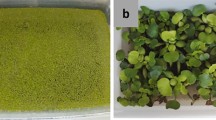Abstract
Eichhornia crassipes was tested for its ability to bioconcentrate 8 toxic metals (Ag, Cd, Cr, Cu, Hg, Ni, Pb, and Zn) commonly found in wastewater from industries. Young plants of equal size were grown hydroponically and amended with 0, 0.1, 0.3, 0.5, 1.0, 3.0, and 5.0 mM of each heavy metal individually for 21 days. The test plant had the lowest and the highest tolerance indices for Hg and Zn, respectively. A significant (P ≤ .05) reduction in biomass production was observed in metal treated plants compared with the control. All strace elements accumulated to higher concentrations in roots than in shoots. Trace element concentrations in tissues and the bioconcentration factors (BCF) were proportional to the initial concentration of individual metal in the growth medium and the duration of exposure. From a phytoremediation perspective, E. crassipes is a promising plant species for remediation of natural water bodies and/or wastewater polluted with low levels of Zn, Cr, Cu, Cd, Pb, Ag and Ni.
Similar content being viewed by others
References
Causton, D. R. (1994). Plant growth analysis: A note on the variability of Unit Leaf Rate (Net Assimilation Rate) within a sample. Annals of Botany, 74, 513–518.
Chaney, R. L., Ryan, J. A., & Brown, S. L. (1999). Environmentally acceptable endpoints formetals. In: W. C. Anderson, R. Loehr, & D. Reibe (Eds.), Environmental availability in soil:chlorinated organics explosives and metals (pp. 111–115). Annapolis, USA: Am. Acad. Environ. Eng.
Clijsters, H., Cuypers, A., & Vangronsveld, J. (1999). Physiological response to heavy metals in higher plants; Defence against oxidative stress. Zeitschrift für Naturforschung, 54c, 730–734.
Delgado, M., Guardiola, E., & Bigeriego, M. (1995). Organic and inorganic nutrients removal from pig slurry by water hyacinth. Journal of Environmental Science and Health, Part A, 30, 1423–1434.
Eze, J. M. O. (1965). Studies on growth regulation, salt uptake and translocation. Ph.D thesis, University of Durham, UK, pp. 31–37.
Falbo, M. B., & Weaks, T. E. (1990). A comparison of Eichhornia crassipes (Pontederiaceae) and Sphagnum quinquefarium (Sphagnaceae) in treatment of acid mine water. Economic Botany, 44, 40–49.
Hansen, D., Duda, P. J., Zayed, A., & Terry, N. (1998). Selenium removal by constructed wetlands: Role of biological volatilization. Environmental Science & Technology, 32, 591–597.
Hoagland, D. R., & Arnon, D. I. (1938). The water culture method for growing plants without soil. California, USA: California Agriculture Experimental Station Bulletin, 347, Berkeley.
Lambert, M., Pierzynski, G., Erickson, L., & Schnoor, J. (1997). Remediation of lead, zinc and cadmium contaminated soils. In: R. Hester & R. Harrison (Eds.), Contaminated land and its reclamation (pp. 91–102). Cambridge: The Royal Society of Chemistry.
Lasat, M. M. (2002). Phytoextraction of toxic metals: A review of biological mechanisms. Journal of Environmental Quality, 31, 109–120.
Lasat, M. M., Pence, N. S., Garvin D. F., Ebbs S. D., & Kochian, L. V. (2000). Molecular physiology of zinc transport in the Zn hyperaccumulator Thlapsi caerulescens. Journal of Experimental Botany, 51, 71–79.
Lytle, C. M., Zayed, A., Terry, N., & Lytle, F. W. (1996). Phyto-conversion of Cr(iv) to Cr(iii) by water hyacinth: A case for phytoremediation. Abstracts of the annual combined meeting of the Ecological Society of America on Ecologists/Biologists as problem solvers providence, RI.
Marchiol, L., Assolari, S., Sacco, P., & Zerbi, G. (2004). Phytoextraction of heavy metals by canola (Brassica napus) and radish (Raphanus sativus) grown on multicontaminated soil. Environmental Pollution, 132, 21–27.
McCutcheon, S. C., & Schnoor, J. L. (2003). Overview of phytotransformation and control of wastes. In S. C. McCutcheon, J. L. Schnoor (Eds.), Phytoremediation: Transformation and control of contaminants (pp. 3–58). New York: Wiley and Sons.
Muramoto, S., & Oki, Y. (1983). Removal of some heavy metals from polluted water by water hyacinth (Eichhornia crassipes). Bulletin of Environmental Contamination and Toxicology, 30, 170–177.
Noggle, G. R., & Fritz, G. J. (1976). Introductory plant physiology (p.␣688). Great Britain: Prentice-Hall Inc.
Oncel, I., Kele, Y., & Ustun, A. S. (2000). Interactive effects of temperature and heavy metal stress on the growth and some biochemical compounds in wheat seedlings. Environmental Pollution, 107(3), 315–320.
Pandey S. N., & Sinha, B. K. (1995). Plant physiology (3rd revised ed., p. 582). New Delhi: Vikas Publishing House PVT Limited.
Pilon-Smit, E. (2005). Phytoremediation. Annual Review of Plant Biology, 56, 15–39.
Qian, J. H., Zayed, A., Zhu, Y. L., Yu, M., & Terry, N. (1999). Phytoaccumulation of trace elements by wetland plants: III. Uptake and accumulation of ten trace elements by twelve plant species. Journal of Environmental Quality, 28, 1448–1455.
Terry, N., Zayed, A., Pilon-Smits, E., & Hansen, D. (1995). Can plants solve the selenium problem? In Proc. 14th Annu. Symp., Curr. Top. Plant Biochem., Physiol. Mol. Biol.: Will Plants Have a Role in Bioremediation?, Univ. Missouri, Columbia, April 19–22, pp. 63–64.
Wilkins, D. A. (1978). The measurement of tolerance to edaphic factors by means of root growth. New Phytology, 80, 623–633.
Wolverton, B. C., & McDonald, R. C. (1979). Water hyacinth (Eichhornia crassipes) productivity and harvesting studies. Economic Botany, 33, 1–10.
Xia, H., Wu, L., & Tao, Q. (2003). A review on phytoremediation of organic contaminants. Chinese Journal of Applied Ecology, 14, 457–460.
Ye, Z. H., Baker, A. J. M., Wong, M. H., & Willis, A. J. (1997a). Copper and nickel uptake, accumulation and tolerance in Typha latifolia with and without iron plaque on the root surface. New Phytology, 136, 481–488.
Ye, Z. H, Baker, A. J. M., Wong, M. H., & Willis, A. J. (1997b). Zinc, lead and cadmium tolerance, uptake and accumulation by common Reed, Phragmites australis. Annals of Botany, 80, 363–370.
Zayed, A., Gowthaman, S., & Terry, N. (1998). Phytoaccumulation of trace elements by wetland plants: I. Duckweed. Journal of Environmental Quality, 27, 715–721.
Author information
Authors and Affiliations
Corresponding author
Rights and permissions
About this article
Cite this article
Odjegba, V.J., Fasidi, I.O. Phytoremediation of heavy metals by Eichhornia crassipes . Environmentalist 27, 349–355 (2007). https://doi.org/10.1007/s10669-007-9047-2
Received:
Accepted:
Published:
Issue Date:
DOI: https://doi.org/10.1007/s10669-007-9047-2




